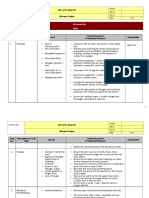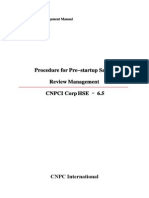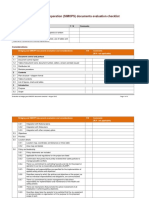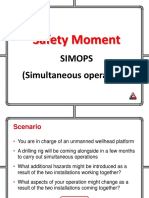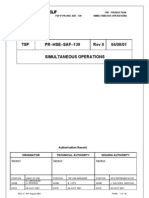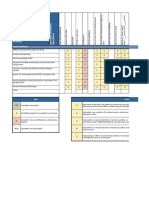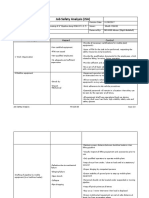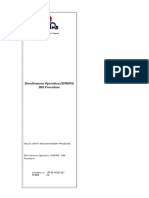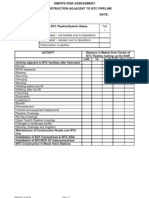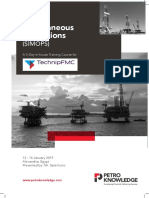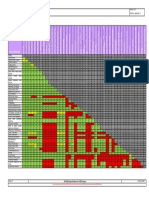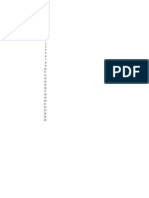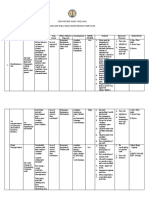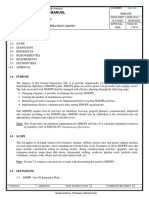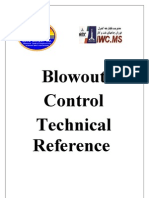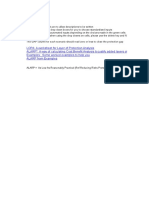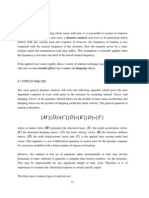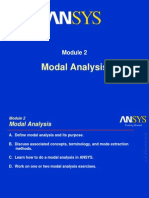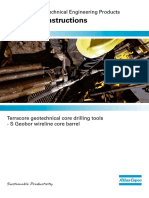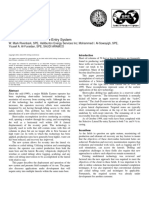80%(10)80% found this document useful (10 votes)
4K viewsSimultaneous Operations (SIMOPS)
Simultaneous Operations (SIMOPS)
Uploaded by
Desmond ChangThis document provides guidelines for planning and conducting simultaneous operations (SIMOPS) to ensure safety in the Gulf of Mexico region. It details requirements for developing a field-specific SIMOPS plan, including defining roles and responsibilities, communication processes, and emergency response procedures. Each SIMOPS plan must be approved by management and kept up to date. Specific personnel are assigned responsibility for overseeing SIMOPS at the field, activity, and vessel level to facilitate coordination and ensure all risks are addressed.
Copyright:
© All Rights Reserved
Available Formats
Download as PDF, TXT or read online from Scribd
Simultaneous Operations (SIMOPS)
Simultaneous Operations (SIMOPS)
Uploaded by
Desmond Chang80%(10)80% found this document useful (10 votes)
4K views19 pagesThis document provides guidelines for planning and conducting simultaneous operations (SIMOPS) to ensure safety in the Gulf of Mexico region. It details requirements for developing a field-specific SIMOPS plan, including defining roles and responsibilities, communication processes, and emergency response procedures. Each SIMOPS plan must be approved by management and kept up to date. Specific personnel are assigned responsibility for overseeing SIMOPS at the field, activity, and vessel level to facilitate coordination and ensure all risks are addressed.
Original Description:
Simultaneous Operations (SIMOPS)
Copyright
© © All Rights Reserved
Available Formats
PDF, TXT or read online from Scribd
Share this document
Did you find this document useful?
Is this content inappropriate?
This document provides guidelines for planning and conducting simultaneous operations (SIMOPS) to ensure safety in the Gulf of Mexico region. It details requirements for developing a field-specific SIMOPS plan, including defining roles and responsibilities, communication processes, and emergency response procedures. Each SIMOPS plan must be approved by management and kept up to date. Specific personnel are assigned responsibility for overseeing SIMOPS at the field, activity, and vessel level to facilitate coordination and ensure all risks are addressed.
Copyright:
© All Rights Reserved
Available Formats
Download as PDF, TXT or read online from Scribd
Download as pdf or txt
80%(10)80% found this document useful (10 votes)
4K views19 pagesSimultaneous Operations (SIMOPS)
Simultaneous Operations (SIMOPS)
Uploaded by
Desmond ChangThis document provides guidelines for planning and conducting simultaneous operations (SIMOPS) to ensure safety in the Gulf of Mexico region. It details requirements for developing a field-specific SIMOPS plan, including defining roles and responsibilities, communication processes, and emergency response procedures. Each SIMOPS plan must be approved by management and kept up to date. Specific personnel are assigned responsibility for overseeing SIMOPS at the field, activity, and vessel level to facilitate coordination and ensure all risks are addressed.
Copyright:
© All Rights Reserved
Available Formats
Download as PDF, TXT or read online from Scribd
Download as pdf or txt
You are on page 1of 19
GoM Region Simultaneous Operations (SIMOPS) Safe Work Practice (SWP) Page 1 of 19
GoM Region Simultaneous Operations (SIMOPS) Safe Work
Practice (SWP)
Document Number: CD # UPS-US-SW-GOM-HSE-DOC-00678-2
Document Authority:
GoM Director Ops
and OMS
Document Custodian: GoM CoW Authority
Scope: GoM H&S Doc Admin:
GoM H&S Document
Management Administrator
Issue Date: 06/12/08 Issuing Dept: GoM H&S
Revision Date: 10/15/12 Control Tier: 2 GoM H&S
Next Review Date: 03/01/15 OMS Element:
3.1 Risk Assessment and
Management
1 Purpose/Scope
This Safe Work Practice (SWP) details the prerequisites and guidelines for the planning and execution of
Simultaneous Operations (SIMOPS) to ensure the safety of personnel and protection of equipment and
the environment.
SIMOPS shall be defined as conducting independent operations in which the events of any one operation
may impact the safety of personnel or equipment or the environment of another operation. Typically this
involves production operations, drilling operations, and project execution operations, but may include any
incidence where concurrent operations create risk.
The SIMOPS prerequisites and guidelines detailed below apply to all operations in the GoM. This
includes but is not limited to: topsides, subsea, drilling, completion, well work, construction, marine, and
pipeline or production activities. This includes activities not only onboard a producing facility but any
simultaneous operations that occur field- or lease-wide.
2 Key Responsibilities
Proper coordination, communication and control are critical to the safe conduct of SIMOPS.
3 General Requirements
It is the intent of these guidelines to establish procedures for planning and coordination and outline rules
to ensure that SIMOPS are conducted without incident.
3.1 Field SIMOPS Plan
Each field in the GoM shall have an approved field SIMOPS plan. A "field" is defined as any BP-operated
developing or producing operation. SIMOPS plans may be required for operations outside of a field
where SIMOPS risks exist between concurrent operations.
This document should be kept evergreen and shall include:
Field description or project area description (including all fixed obstructions, infrastructure, and
bathymetry)
A field SIMOPS matrix (see Appendix B in this chapter for definitions of some example areas this
should cover) that includes pre-risk assessed activities (see Appendix C in this chapter for an
example matrix)
Organization and Roles and Responsibilities
Daily communications process specifying time and participants; the daily written report requirements
and distribution must also be defined
Control Tier: 2-GoM H&S Revision Date: 06/15/12
Document Number: UPS-US-SW-GoM-HSE-DOC-00678-2 Print Date: 11/30/2012
PAPER COPIES ARE UNCONTROLLED. THIS COPY VALID ONLY AT THE TIME OF PRINTING.
GoM Region Simultaneous Operations (SIMOPS) Safe Work Practice (SWP) Page 2 of 19
Key contact information
The plan shall include or reference existing procedures for:
Description of emergencies and All Stop Criteria
Emergency Response and Incident Notification Procedure
Identification of Health, Safety, Security and Environment (HSSE) plan. If a contractor plan is being
used, a bridging document must exist that reconciles the BP and contractor GoM HSE policies.
Identification of Control of Work processes, including MOCs for change-out of key personnel
The plan should consider additional resources that may be required based on field activity complexity,
such as a dedicated SIMOPS coordinator.
The field SIMOPS plan shall be in compliance with the BSEE, Coast Guard, BSEE approved Deep Water
Operations Plan (DWOP) and class regulations.
Any deviation from or changes to an approved SIMOPS plan requires Management of Change with
appropriate Line and Technical Authority sign-off. This should include the SIMOPS plan signature
authority and should be communicated and understood by all affected parties (see Section 4.4.2).
Everyone has the duty to stop the job at any time the SIMOPS plan is not, or cannot be followed, or at
any time the SIMOPS plan is not clear.
The appropriate Vice President or Area Operations Manager is accountable for ensuring this field
SIMOPS plan is kept up to date and is the highest level of sign-off. This should be a controlled document
stored in the appropriate document management database.
3.2 Adding an Activity to the Field SIMOPS Plan
For each new activity which involves field SIMOPS the following documents are required:
Work plan/pack and detailed procedure
Risk assessment of that procedure, including risk assessment of SIMOPS
A reference document that addresses the requirements outlined in Section 3.1 above with particular
emphasis on roles and accountabilities
3.3 Development of Field SIMOPS Plan
Roles Responsibilities
Vice President or Area
Operations Manager
Ensures that the field has a SIMOPS Plan
Final level of approval for the field SIMOPS plan
Operations Support
Lead or Equivalent
Accountable for additional activity approval
Field SIMOPS plan preparation
Offshore Installation
Manager
Accountable for field SIMOPS plan content
Project Manager Accountable for their project's additional activity SIMOPS requirements
(per Section 3.2) to supplement the field SIMOPS plan
Act as integrator, working with the Activity Person in Charge (see
Section 3.4) to ensure planned activities are aligned with the field
SIMOPS plan in advance
Ensure planned field activities are included in the Integrated Field
Planning (IFP) process
Control Tier: 2-GoM H&S Revision Date: 06/15/12
Document Number: UPS-US-SW-GoM-HSE-DOC-00678-2 Print Date: 11/30/2012
PAPER COPIES ARE UNCONTROLLED. THIS COPY VALID ONLY AT THE TIME OF PRINTING.
GoM Region Simultaneous Operations (SIMOPS) Safe Work Practice (SWP) Page 3 of 19
3.4 Execution of SIMOPS Plan
Each field shall appoint a field SIMOPS team. The field SIMOPS team shall include at a minimum the
following individual roles and responsibilities
Roles Responsibilities
Vice President or Area
Operations Manager
Ensures field SIMOPS plan is followed and is working
Operations Support Lead
or Equivalent
Accountable for allocating adequate resources to support the field
SIMOPS plan
OIM/Field Person-In-
Charge (FPIC)
The Field Person-in-Charge (FPIC) is the BP Offshore Installation Manager
(OIM) unless otherwise stated. This individual is accountable for execution
of the field SIMOPS plan and will have complete control to determine
which operation or phase of work has precedence at any given time. The
FPIC shall communicate daily with the Activity Person(s)-in-Charge (APIC)
with respect to field SIMOPS activity. The FPIC or designee shall
communicate with each Vessel Person(s)-in-Charge (VPIC) upon entry and
departure from the particular field
Accountable for execution of the field SIMOPS plan
Ensures that all key stakeholders (rig, vessel and facilities) are briefed
and engaged, including contractors. Must have broad communications
across the crews and shifts
Monitor daily field SIMOPS activity
Chair daily field SIMOPS review(s) (daily call)
Evaluate the risk of planned simultaneous operations and ensure
mitigation plans are in place
Project Manager Facilitate the briefing and engagement of key stakeholders, including
contractors, and report back to the OIM for approval that engagement
has been adequate
Activity Person-in-Charge
(APIC)
The individual accountable for executing a specific defined activity. The
APIC shall communicate with the FPIC with respect to field SIMOPS
activity. When a marine vessel/unit is a component of the activity, the APIC
shall also be accountable for vessel coordination. The APIC shall
communicate with the respective VPIC with respect to executing the
marine activity. Examples of potential APICs are a Operations Support
Lead or Equivalent, Well Site Leader or BP Representative on a vessel
When a single vessel is performing the activity, the APIC may assume the
additional accountabilities of the VPIC.
Monitor daily SIMOPS activity
Facilitate daily activity SIMOPS review(s)
Attend daily field SIMOPS review(s)
Ensure that risks associated with the planned operations are
understood and communicated to the FPIC
Accountable for executing a specific defined activity. When a marine
vessel/unit is a component of the activity, the APIC shall also be
accountable for vessel coordination
Vessel Person-in-Charge
(VPIC)
The individual aboard the vessel accountable for executing that specific
vessel's activity under the direction of the APIC. The VPIC shall
Control Tier: 2-GoM H&S Revision Date: 06/15/12
Document Number: UPS-US-SW-GoM-HSE-DOC-00678-2 Print Date: 11/30/2012
PAPER COPIES ARE UNCONTROLLED. THIS COPY VALID ONLY AT THE TIME OF PRINTING.
GoM Region Simultaneous Operations (SIMOPS) Safe Work Practice (SWP) Page 4 of 19
Control Tier: 2-GoM H&S Revision Date: 06/15/12
Document Number: UPS-US-SW-GoM-HSE-DOC-00678-2 Print Date: 11/30/2012
PAPER COPIES ARE UNCONTROLLED. THIS COPY VALID ONLY AT THE TIME OF PRINTING.
Roles Responsibilities
communicate with the APIC with respect to activity SIMOPS. The VPIC
shall communicate with the FPIC prior to entry, upon entry and upon
departure from the particular field. The VPIC shall also be accountable for
monitoring onboard vessel SIMOPS and identifying and reporting any
SIMOPS activity that may impact the vessel's ability to perform the
intended work scope (activity). In some circumstances the FPIC and APIC
can be the same person; and the APIC and VPIC can be the same person.
Examples of potential VPICs are a Well Site Leader, BP Representative on
a vessel, MODU OIM, Captain, Mate or Dynamic Position Operator
Monitor daily vessel SIMOPS activity
Facilitate daily vessel SIMOPS review(s)
Attend daily activity SIMOPS review(s)
Attend daily field SIMOPS review(s) - upon request
Execute specific vessel activity under the direction of the APIC
Officer-in-Charge The Officer in Charge of the navigational watch is the master's
representative and is primarily responsible at all times for the safe
navigation of the vessel. Examples of potential Officers in Charge are a
MODU OIM, Captain, Mate or Dynamic Position Operator
Field SIMOPS
Coordinator
(FSC)
The FSC, if needed as an additional resource, shall provide support to the
OIM and field SIMOPS team. Depending on the complexity of the activity
set, the FPIC and asset management may determine a dedicated FSC is
required
4 General Procedure
4.1 Identify Scope of SIMOPS Activity
Each asset must have a process in place to clearly define a detailed work scope of the field SIMOPS
activity to allow for an appropriate level risk assessment to be performed. The scope must be defined
early enough so that the activity risk assessment can be referenced against the asset's scheduled work
activities to ensure any known SIMOPS conflicts are addressed. The Integrated Field Planning (IFP)
process may be utilized to satisfy the criteria and timescale for this advance notice requirement. A typical
SIMOPS process flow chart is shown in Appendix D.
4.2 Risk Assessment
An appropriate level risk assessment should be conducted and should include known SIMOPS risks by
referencing the published field activity schedule. Some key SIMOPS risks would include dropped objects,
vessel collision, aviation, construction (including subsea) diving, DP failure, and loss of containment of
hydrocarbons. (Refer to Appendix E in this SWP for an example of a dropped objects prevention and
mitigation plan checklist.)
A daily risk assessment discussion should also take place as part of the 24 hour look ahead during the
daily SIMOPS meeting.
Additionally, a SIMOPS matrix (BP) or equivalent tool to evaluate risks shall exist for each SIMOPS plan.
4.3 Risk Mitigation
For risks identified in risk assessments, mitigation controls should be identified and put into place. Clearly
defined All Stop Criteria (with defined approval authorities) should also be outlined as part of the risk
mitigation process. In addition to mitigation controls resulting from risk assessments such as the
GoM Region Simultaneous Operations (SIMOPS) Safe Work Practice (SWP) Page 5 of 19
Dropped Objects Study, the field SIMOPS plan shall include a process to mitigate risk on a daily basis. If
additional risks are identified during the established, daily communications forum, mitigation controls
must be executed before the activity can commence or continue. Identification of these mitigation
controls may require a separate discussion outside of the daily communication forum.
4.4 Communication/Training of Field SIMOPS Plan and Activity Specific Information
No activity should take place prior to approval of the SIMOPS plan and appropriate communication and
training. The field SIMOPS plan shall be reviewed with all project manager(s), the Operations Support
Lead or Equivalent and the appropriate APICs and FPICs prior to execution of any SIMOPS activities. The
field SIMOPS plan shall be inclusive of any activity specific information as defined in Section 3.1. The
review of the plan shall be completed as early as necessary to allow for a clear understanding of the risks
and mitigation controls. If multiple shifts or crews will be engaged in this SIMOPS activity, then more
than one review may be required to cover all crews/shifts.
4.4.1 Communication during Execution of SIMOPS Activity Plan
During the execution of the field SIMOPS plan for a SIMOPS activity, daily routine verbal and written
communication must occur as defined in the plan. Participants should ensure all work groups clearly
understand the scope of work that is forecast for the next 24 hours with an emphasis on SIMOPS risk
mitigation. Ensure standing orders are in place for non-routine communications and provide clear
instructions as to when to notify the FPIC.
4.4.2 Changes to Work Scope
Stop the job, assess the risks, and initiate an MOC, if required, for all changes in work scope after the
activity risk assessment and approved mitigation controls have been established.
4.5 Drilling, Completion, Remedial Rig Operations, or Well Maintenance near
Producing Infrastructure
4.5.1 Potential Undesirable Events and Mitigation
Well control is a primary concern during these operations. If there is difficulty in maintaining well control
(e.g., unexpected pressures, gas cut mud, lost circulation, etc.), joint communications shall occur with all
parties (production, drilling, etc.) to determine if production operations should be shut in. Well control
procedures should be followed carefully.
Note: First priority must be given to controlling the well and to the safety of the personnel on board.
The greatest well control hazard is wellbore intersection with a producing well. Prior directional planning
is intended to avoid this interference. The plan should be reviewed by the appropriate individuals (Wells
Manager, Wells Program Manager, etc.).
Critical areas of SIMOPS are defined as areas in which explosive or ignitable mixtures are present or
potentially present due to the release of flammable gases or vapors. During simultaneous operations,
care shall be taken to avoid potential sources of ignition and damage to equipment in such areas. Critical
areas include the wellheads, mud tanks and pumps, shale shaker, degasser, de-sander, producing wells,
and all equipment for field processing of oil and gas.
4.5.2 Regulatory Requirements
In addition to the above general requirements, the BSEE has specific requirements for conducting rig
operations in close proximity to production facilities and other hazards.
The regulation at 30 CFR 250.406 requires the shut-in of all producible wells located in the affected well
bay below the surface and at the wellhead when (1) a drilling rig or related equipment is moved on or off
a platform, (2) a drilling unit is moved or skid between wells on a platform, or (3) a mobile offshore drilling
Control Tier: 2-GoM H&S Revision Date: 06/15/12
Document Number: UPS-US-SW-GoM-HSE-DOC-00678-2 Print Date: 11/30/2012
PAPER COPIES ARE UNCONTROLLED. THIS COPY VALID ONLY AT THE TIME OF PRINTING.
GoM Region Simultaneous Operations (SIMOPS) Safe Work Practice (SWP) Page 6 of 19
unit (MODU) is moved within 500 feet of a platform. You may resume production once the MODU is in
place, secured, and ready to begin drilling operations.
The Appendices to the Rig Move NTL No. 2004-G09 provide guidance on how to comply with 30 CFR
250.406. They describe the various types of rigs and phases of rig movement, specify when wells must
be shut in, and delineate the documentation to be submitted to the appropriate BSEE Gulf of Mexico
OCS Region (GOMR) District Office to obtain approval for a departure under 30 CFR 250.142.
The Shallow Hazards NTL No. 2007-G01 includes requirements for moving rigs near pipelines and other
seafloor hazards. This includes onsite preparation and rig move requirements.
4.5.3 BP Requirements
BP's Global Drilling and Well Operations Policy has specific requirements for conducting risk
assessments prior to moving a rig onto an offshore location, conducting risk assessments for
simultaneous operations and collision avoidance while drilling on multi-well locations.
4.6 Marine
SIMOPS involving marine vessels/units shall be managed consistent with the field SIMOPS plan.
4.6.1 Identify Activity
The field SIMOPS plan shall contain or reference a process for identifying and monitoring marine activity.
4.6.2 Risk Assessment (Identify and Evaluate Risks)
Collision is the primary SIMOPS marine risk. Any marine vessel/unit operating less than 500 meters from
another marine vessel/unit or hazard to navigation shall be deemed a marine risk. Circumstances that
may contribute to collision risk are vessel traffic density, environmental conditions (visibility, sea state,
wind, and current), navigational aids status, vessel maneuvering characteristics and capabilities,
temporary measures in effect, vessel position reference systems, acoustic management, vessel defects
and other special circumstances. Details on marine SIMOPS guidance can be found in Appendix G in
this SWP.
4.7 Subsea Operations
Subsea operations may be conducted in the field to support any one of the following activities:
construction, production, drilling, and seabed surveys. Each has a unique set of risks (e.g. collision,
dropped object) to be managed via a SIMOPS plan.
4.7.1 ROV Activities
Remotely Operated Vehicles (ROVs) may be deployed from any one of the production facilities, Mobile
Offshore Drilling Units (MODUs) or in-field vessels and could be in support of production optimization
(valve operation), inspection, repair, or component replacement, maintenance and underwater
construction. Typically this will be carried out at seabed facilities, risers, pipelines, dynamic umbilicals,
moorings, floating hulls and jackets.
4.7.2 Diving Activities
Diving activities typically are required only for critical maintenance and inspection of near-surface facilities
such as jacket structures, sea chest valves, and riser porches. In addition to compliance with the field
SIMOPS plan, to manage risk, diving operations will be performed in strict compliance with BP GoM
Diving Procedures.
4.7.3 Underwater Construction Activities
This includes installation and recovery of risers, manifolds, pipelines, trees, flow line jumpers, umbilicals
and associated sub-structures. This may be performed from and with a range of facilities and techniques.
Control Tier: 2-GoM H&S Revision Date: 06/15/12
Document Number: UPS-US-SW-GoM-HSE-DOC-00678-2 Print Date: 11/30/2012
PAPER COPIES ARE UNCONTROLLED. THIS COPY VALID ONLY AT THE TIME OF PRINTING.
GoM Region Simultaneous Operations (SIMOPS) Safe Work Practice (SWP) Page 7 of 19
4.7.4 Survey Activities
Surveys may be performed at the seabed typically by a number of vessel surface supported techniques,
such as seismic, core sampling, route corridor surveys and metrology. In addition to ROVs, there are
circumstances where non-surface connected autonomous ROVs may be deployed to carry out such
functions.
Control Tier: 2-GoM H&S Revision Date: 06/15/12
Document Number: UPS-US-SW-GoM-HSE-DOC-00678-2 Print Date: 11/30/2012
PAPER COPIES ARE UNCONTROLLED. THIS COPY VALID ONLY AT THE TIME OF PRINTING.
GoM Region Simultaneous Operations (SIMOPS) Safe Work Practice (SWP) Page 8 of 19
5 Appendices, Key Documents, Tools, References
Control Tier: 2-GoM H&S Revision Date: 06/15/12
Document Number: UPS-US-SW-GoM-HSE-DOC-00678-2 Print Date: 11/30/2012
PAPER COPIES ARE UNCONTROLLED. THIS COPY VALID ONLY AT THE TIME OF PRINTING.
GoM Region Simultaneous Operations (SIMOPS) Safe Work Practice (SWP) Page 9 of 19
Appendix A:
SIMOPS Acronyms List
Acronym Definition
AOM Area Operations Manager
APIC Activity Person In Charge
BOP Blow Out Preventer
CDP Company Designated Person
D&C Drilling and Completions
DP Dynamic Positioning
DWOP BSEE-approved Deepwater Operations Plan
FPIC Field Person In Charge
FSC Field SIMOPS Coordinator
HAZID Hazard Identification
HAZOP Hazard and Operability Study
HSSE Health, Safety, Security, Environment
IFP Integrated Field Planning
J SEA/RA J ob Safety and Environmental Analysis/Risk Assessment
MASP Maximum Anticipated Surface Pressure
MODU Mobile Offshore Drilling Unit
OIM Offshore Installation Manager
OM Operations Manager
PIC Person in Charge
PM Project Manager
POB Personnel on Board
PTW Permit to Work
ROV Remotely Operated Vehicle
RP Recommended Practice
SCR Steel Catenary Riser
SCSSV Surface Controlled Subsurface Safety Valve
SIMOPS Simultaneous Operations
SWP Safe Work Practice
TBD To Be Determined
USCG United States Coast Guard
VMS Vessel Management System
VPIC Vessel Person In Charge
VRP Vessel Response Plan (Coast Guard-related)
Control Tier: 2-GoM H&S Revision Date: 06/15/12
Document Number: UPS-US-SW-GoM-HSE-DOC-00678-2 Print Date: 11/30/2012
PAPER COPIES ARE UNCONTROLLED. THIS COPY VALID ONLY AT THE TIME OF PRINTING.
GoM Region Simultaneous Operations (SIMOPS) Safe Work Practice (SWP) Page 10 of 19
Appendix B:
Typical SIMOPS Activity Definitions
Activity Definition
Boat Operations
Boat alongside Platform operations include offloading and back
loading of cargo or bulk material from workboat.
BOP Lifting/Handling
Movement of BOP(s), BOP equipment over well slots, hydrocarbon
piping, flexible flowlines and hoses.
Bulk Methanol/Diesel
Transfer
Operations that include moving these flammable fluids through a
hose.
Coiled Tubing
Operations
Any entry into a well with coiled tubing.
Coiled Tubing
(through rotary)
Work done as part of the drilling/completion or workover operation
(from Rig Floor).
Completion Operations Workover rig and drilling rig activities.
Confined Space Entry
Personnel working in confined spaces where insufficient oxygen,
toxic or combustible gases may be present. Any space enclosed or
partially enclosed area, either above or below deck with limited
access.
Construction Operations
Equipment installation, removal or modification, repairs to processing
systems, pipelines or the platform structure; and crane lifts
considered as heavy lifts per BSEE or the Crane Operation
Maintenance Program or any equipment or materials that could
penetrate a deck plate if dropped while over wells and production
equipment.
Cold Construction
Operations
Any cold work or construction/repair activities with contract crews.
Installation of equipment not requiring opening of vessels or welding,
etc.
Excess Casing Pressure
(Operations)
Pressure on A or B annulus in excess of 20% of design pressure.
Derrick Barge (Lifting)
Time period when barge moves to a position where a decision is
made to shut down operations and/or begins to make lifts toward the
platform, until lift is set and lifting equipment is away from the
platform. Period could start when the barge approaches the platform
if there is some other need to apply restrictions, such as excessive
flare radiation.
Diving
Diving to inspect or do maintenance whether from the facility or
another vessel. Non-ROV.
Drilling (unknown area)
Drilling in unfamiliar areas where you have no past experience in
formation, pressures or hole trends.
Drilling in Reservoir
Drilling in known area. Drilling in hole section with known/expected
hydrocarbons.
Drilling Riserless
Drilling operations conducted without a riser installed between the
wellhead and the surface facility.
Control Tier: 2-GoM H&S Revision Date: 06/15/12
Document Number: UPS-US-SW-GoM-HSE-DOC-00678-2 Print Date: 11/30/2012
PAPER COPIES ARE UNCONTROLLED. THIS COPY VALID ONLY AT THE TIME OF PRINTING.
GoM Region Simultaneous Operations (SIMOPS) Safe Work Practice (SWP) Page 11 of 19
Control Tier: 2-GoM H&S Revision Date: 06/15/12
Document Number: UPS-US-SW-GoM-HSE-DOC-00678-2 Print Date: 11/30/2012
PAPER COPIES ARE UNCONTROLLED. THIS COPY VALID ONLY AT THE TIME OF PRINTING.
Activity Definition
Explosives above
Mudline
Electro-explosive devices (detonators) in wireline operations;
perforators, pipe cutters, severing tools and string shot (back-off).
Fire and Gas / ESD
Inoperable
Fire and gas system and/or Emergency Shut Down (ESD) inoperable
or placed out of service.
Flaring
Depressurization or venting of process vessel or compressors via
flare system.
Heavy Lifts (Platform,
Crane) Over Live
Production Equipment
Heavy lifts over production equipment includes Platform cranes or
from a barge/workboat. Platform crane lifts which exceed 75% of
rated load limit, at a given angle, are considered heavy lifts. Heavy
lifts by platform cranes require that wells, pressurized lines, and
production facilities located in the path of heavy lifts be shut-in if not
protected by solid steel decking.
Hot Work (Outside
Designated Areas)
Hot work is defined as any activity, which generates a spark, flame or
other ignition source under normal conditions. Welding in any
location of the platform other than the designated safe welding area.
Most likely includes major/minor construction projects and includes
safety work plans with OIM approval.
Hull Internal Inspection Entry in hull below water-tight doors.
Open Hydrocarbon
Systems
Open vessels, piping open to atmosphere prior to positive isolation
and purging.
Over side Work
Work outside handrails, over open area or water. Work within green
tagged scaffolding is NOT considered over side work.
Painting/Coating
Painting and coating at offshore location and discharge regulations
also apply.
Pigging (Export Lines)
Work associated with loading, running and retrieving a pig out of an
export pipeline.
Pipeline Operations
Any and all activity related to pipeline operations, with operations
including all pipelines in the area, BP operated or third party
operated. The pipeline includes risers, SCRs, PLETS, Wye Sleds,
Subsea Tie-ins, Launchers, Receivers and other pipeline
appurtenances for the transportation of oil, gas and products.
Pressure Testing
(BOP, Casing, etc.)
Pressure testing during drilling operations involving BOPs and casing.
Also, involving a lubricator, BOPs and grease injection head, or a
shooting nipple, i.e., pressure control equipment during any wireline
work.
Production Operations Flowing of any well, except as part of a back surge.
ROV Activity
Remotely Operated Vehicle (ROV) activity in controlled area of the
field.
Running Riser Running of outer production riser or drill riser.
Securing Wells
Any time wells are shut in due to heavy lifts in the well bay or for
hurricane evacuation, the SSVs, manual masters and the SCSSVs will
be closed. Once the wells are shut in, the umbilicals and flowlines
need to be bled down.
Skidding Drill Rig Movement of rig or major components on the deck of the facility.
Snubbing Live Well
Snubbing Operations associated with well control or production
operations. A formal detailed prognosis will be developed and
GoM Region Simultaneous Operations (SIMOPS) Safe Work Practice (SWP) Page 12 of 19
Control Tier: 2-GoM H&S Revision Date: 06/15/12
Document Number: UPS-US-SW-GoM-HSE-DOC-00678-2 Print Date: 11/30/2012
PAPER COPIES ARE UNCONTROLLED. THIS COPY VALID ONLY AT THE TIME OF PRINTING.
Activity Definition
outlined for each snubbing operation. Snubbing operations concerns
are pollution and uncontrolled well flow.
Well Clean-Up
Unloading of Well, start up/clean up prior to directing well to normal
flow path.
Well Control
(Drilling)
Well control conditions and the corrective actions necessary to
maintain proper well control. Any time primary well control is lost
either downhole or at surface.
Well Control
(producing)
Abnormal well control conditions and the corrective actions
necessary to maintain well control on Producing Well.
Well Stimulation
(through Rotary)
Work done as part of the drilling/completion/workover operations.
Wellbore Proximity
(Collision)
Conducting drilling operations where there is potential for
intersection with an existing wellbore.
Wireline
(Production Operations)
Wire line electrical or slick line on producing well. Work not done as
part of the drilling/completion or workover operation. (Not done from
rig floor).
Wireline (Rig Operations)
Wireline electrical or slickline through rotary. Electric or slickline
operations from the rig floor.
Workover Operations
A conventional or concentric workover activity when performing
remedial work on any wells.
GoM Region Simultaneous Operations (SIMOPS) Safe Work Practice (SWP) Page 13 of 19
Control Tier: 2-GoM H&S Revision Date: 06/15/12
Document Number: UPS-US-SW-GoM-HSE-DOC-00678-2 Print Date: 11/30/2012
PAPER COPIES ARE UNCONTROLLED. THIS COPY VALID ONLY AT THE TIME OF PRINTING.
Appendix C:
Example SIMOPS Matrix (Atlantis)
GoM Region Simultaneous Operations (SIMOPS) Safe Work Practice (SWP) Page 1 of 19
Control Tier: 2-GoM H&S Revision Date: 06/15/12
Document Number: UPS-US-SW-GoM-HSE-DOC-00678-2 Print Date: 11/30/2012
PAPER COPIES ARE UNCONTROLLED. THIS COPY VALID ONLY AT THE TIME OF PRINTING.
GoM Region Simultaneous Operations (SIMOPS) Safe Work Practice (SWP) Page 1 of 19
Appendix D:SIMOPS Process Flow Chart
Control Tier: 2-GoM H&S Revision Date: 06/15/12
Document Number: UPS-US-SW-GoM-HSE-DOC-00678-2 Print Date: 11/30/2012
PAPER COPIES ARE UNCONTROLLED. THIS COPY VALID ONLY AT THE TIME OF PRINTING.
GoM Region Simultaneous Operations (SIMOPS) Safe Work Practice (SWP) Page 2 of 19
Appendix E:
Dropped Objects Plan Guidance
Severe damage to subsea infrastructure is a major concern due to dropped objects as well as damage
due to BOP lift-off and well-to-well BOP moves.
A Dropped Objects Prevention and Mitigation Plan must be developed to ensure infrastructure is
protected and that there is a contingency plan in effect should there be a dropped objects incident.
The Dropped Objects Prevention and Mitigation Plan typically should include:
Actions following a dropped object incident
Preemptive production shut-in:
During special deployments and recoveries if winch or crane systems are in use
During open water works
During seabed construction activities
During BOP well-to-well move
During tie-in of wells and infrastructure
Where the system may be exposed to only one barrier between hydrocarbon production and the
environment
Production equipment maintenance
Well intervention
Other activities considered risky and outside the planned activities
Emergency production shut-in using an emergency shut-in system
Dropped load during vessel-to-vessel transfer
Dropped load during a load deployment or recovery with a winch or drill pipe
Control Tier: 2-GoM H&S Revision Date: 06/15/12
Document Number: UPS-US-SW-GoM-HSE-DOC-00678-2 Print Date: 11/30/2012
PAPER COPIES ARE UNCONTROLLED. THIS COPY VALID ONLY AT THE TIME OF PRINTING.
GoM Region Simultaneous Operations (SIMOPS) Safe Work Practice (SWP) Page 3 of 19
Appendix G:
Marine SIMOPS Risk Management
Acoustic Management Plan Guidance
An acoustic frequency management plan is developed when two or more vessels in the same area are
using acoustics for position referencing, ROV tracking, clump weight tracking and surveying. The plan is
needed to ensure maximum vessel safety and to avoid acoustic disruptions.
The Frequency Management Plan assumes there is no safe distance where acoustics will not interfere. A
typical acoustic frequency management plan will list frequencies in the Medium Frequency (MF) band of
19-kHz to 36-kHz band width where a frequency separation of 500-Hz is used. A 250-Hz separation may
be possible, but opens up the possibility of extensive interference. A separation of 500-Hz is, therefore,
recommended.
A frequency management plan produces a set of compatible channel allocations and guidelines that will
allow each vessel to operate freely and without concern as to the effect their acoustic operations may
have on other vessels nearby. There is no need to enable and disable channels, which improves
efficiency and safety.
A more extensive plan may be developed for multiple vessel and survey operations. Use of a digital
acoustic system opens up to an increased number of safe channels in the MF band. Use of 28 carrier
frequencies combined with 16 codes give 448 unique frequencies, i.e., 224 interrogation and 224 reply
frequencies. This system has little or no affect on any tone-based acoustics, specifically High Precision
Acoustic Positioning (HiPap).
A seismic survey operation generates noise in the water column and may give acoustic disturbance. Any
seismic activity near an area where acoustics are in use needs to be planned. DP operators, in particular,
must be informed of seismic activities to ensure steps are taken during seismic or other acoustic
operations near a dynamically positioned vessel.
Provide Mitigations
The field SIMOPS plan shall include or reference a process to mitigate marine vessel/unit collision risk.
When a Safety Zone is established around a facility, the BP 500 Meter Zone Practice also shall apply.
Every vessel operating in a field shall at all times maintain a proper look-out by sight and by hearing as
well as by all other available means (including radar) appropriate in the prevailing circumstances and
conditions so as to make a full appraisal of the situation and of the risk of collision. The field SIMOPS
team may monitor vessel traffic if deemed necessary.
Vessel congestion, restricted visibility, adverse weather, or other hazardous circumstances require the
control, supervision, or other management of traffic and communications, including specifying times of
entry, movement, or departure from or within a field.
Note:
Nothing in this document or any field SIMOPS plan is intended to relieve any vessel,
owner, operator, charterer, master, or person directing the movement of a vessel from
the consequences of any neglect to comply with any other applicable law or regulation
(e.g., the International Regulations for Prevention of Collisions at Sea, 1972 (72
COLREGS or the Inland Navigation Rules) or of the neglect of any precaution which
may be required by the ordinary practice of seamen, or by the special circumstances
of the case.
Additional Precautions
All non-essential activity on the bridge of vessels in close proximity is not allowed.
Switching between DP station keeping modes shall be avoided in close proximity.
Control Tier: 2-GoM H&S Revision Date: 06/15/12
Document Number: UPS-US-SW-GoM-HSE-DOC-00678-2 Print Date: 11/30/2012
PAPER COPIES ARE UNCONTROLLED. THIS COPY VALID ONLY AT THE TIME OF PRINTING.
GoM Region Simultaneous Operations (SIMOPS) Safe Work Practice (SWP) Page 4 of 19
BOEMRE 30 CFR Subpart 250
BP Drilling and Wells Operations Directional Survey Handbook
6 Definitions
Term Definition
SIMOPS Conducting independent operations in which the events of any one
operation may impact the safety of personnel or equipment or the
environment of another operation
Marine Activity Any and all activity related to BP's operations and use of floating production
units or vessels whether on the high seas, coastal waters, in harbors or on
inland waterways, including marine terminals
Marine Vessel/Unit A generic term covering all vessels/units engaged in marine activity. Any
vessel designed for the carriage of goods, equipment or people on the high
seas, coastal waters or inland waterways, for the provision of services, or
any offshore facility requiring positive buoyancy
Risk Assessment The process of estimating the likelihood that an incident will occur;
estimating the magnitude of the consequential loss, including the
environmental impact, and making a judgment as to the significance of the
risk. The scale of the risk is a function of both likelihood and consequence.
Refer to Integrity Management Standard Element 3 for further information
on risk assessment methodologies
Revision Log
Revision Date Authority Custodian Revision Details
06/15/2012
GoM H&S
Director
GoM Safety
Programs Lead
Reformatted document to meet new GoM
document control template standardization
guidelines. Appendices included in the main
document
03/01/12
GoM HSSE
Director
GoM HSSE
Programs
Manager
Changed Asset Manager references to Area
Operations Managers, Removed OPM
position since all facilities now have OIMS
only, Changed MMS references to BOEMRE
07/17/08
GoM HSSE
Director
GoM HSSE
Programs
Manager
All corrections made were in Section F,
including adding correct links to Appendices,
deleting out-of-date references, and
clarifying the titles of some of the references
06/01/2008
GoM HSSE
Director
GoM HSSE
Programs
Manager
Key requirement is for each field to have an
approved field SIMOPS plan
More rigor and guidance for completing a
SIMOPS plan added
Control Tier: 2-GoM H&S Revision Date: 06/15/12
Document Number: UPS-US-SW-GoM-HSE-DOC-00678-2 Print Date: 11/30/2012
PAPER COPIES ARE UNCONTROLLED. THIS COPY VALID ONLY AT THE TIME OF PRINTING.
GoM Region Simultaneous Operations (SIMOPS) Safe Work Practice (SWP) Page 5 of 19
Control Tier: 2-GoM H&S Revision Date: 06/15/12
Document Number: UPS-US-SW-GoM-HSE-DOC-00678-2 Print Date: 11/30/2012
PAPER COPIES ARE UNCONTROLLED. THIS COPY VALID ONLY AT THE TIME OF PRINTING.
02/28/06
S. Garner/
S. Tink/
R. DeLeonardis/
C. Jackson
Kathy Kanocz
Clarified who is in charge when drilling and
operations on same facility. Added example
simops matrices Atlantis and Na Kika.
Added SIMOPS Work Task Definitions.
Changed CD # from 10074 to UPS-US-SW-
GOM-HSE-DOC-00132-2 to conform to new
numbering nomenclature inside of the new
GoM HSSE doc base. Changed 3 authorities
and 1 custodian.
02/01/02
S. Garner/
B. Herbert/
R. White/
S. Flynn
Ray Britt
Initial issue as controlled document. Prior
revision history located in hard-copy
consolidated manual.
You might also like
- Simultaneous Operation (SIMOPS) : Term of Referance (Tor)Document25 pagesSimultaneous Operation (SIMOPS) : Term of Referance (Tor)kokykarkar88% (8)
- 11 SIMOPs Procedure 11Document14 pages11 SIMOPs Procedure 11riyazali100% (7)
- Manual of Permitted Operations (MOPO)Document7 pagesManual of Permitted Operations (MOPO)Aniekan Akpaidiok100% (2)
- Wire Line Operation and EquipmentDocument122 pagesWire Line Operation and Equipmentmissaoui100% (4)
- Jsa Nitrogen PurgingDocument2 pagesJsa Nitrogen Purgingmohammedsouqi75% (8)
- HSE - 5.7 Procedure For Pre-Startup Safety Review ManagementDocument43 pagesHSE - 5.7 Procedure For Pre-Startup Safety Review Managementazimjoon67% (6)
- Port Facility Security Plan Empty FormDocument37 pagesPort Facility Security Plan Empty FormAbdel Naser AlsheikhNo ratings yet
- SIMOPS Check ListDocument8 pagesSIMOPS Check ListWawan Setiawan100% (3)
- SIMOPs Matrix - Combined - Rev-1Document1 pageSIMOPs Matrix - Combined - Rev-1DebadityachatterjeeNo ratings yet
- HSE Plan - FPSO Topside PDFDocument48 pagesHSE Plan - FPSO Topside PDFdndudc100% (3)
- Safety Moment - SIMOPS Gas VentingDocument7 pagesSafety Moment - SIMOPS Gas VentingfareedfksNo ratings yet
- D and D CatalogDocument139 pagesD and D Catalogmglsite1No ratings yet
- Slickline - Lectures. Tools. OperationsDocument44 pagesSlickline - Lectures. Tools. OperationsOmer Abuzeid100% (3)
- C Simops CBTDocument43 pagesC Simops CBTboypardede3552100% (1)
- SIMOPS Procedure - Pro-Saf-010-Ieoc Rev01-FinalDocument13 pagesSIMOPS Procedure - Pro-Saf-010-Ieoc Rev01-Finalkhaled100% (2)
- Manta To Richmond SIMOPS Risk Matrix FINALDocument1 pageManta To Richmond SIMOPS Risk Matrix FINALDesmond Chang50% (2)
- TSP PR-HSE-SAF-139 Rev 0 04/08/01 Simultaneous Operations: Total Fina ElfDocument18 pagesTSP PR-HSE-SAF-139 Rev 0 04/08/01 Simultaneous Operations: Total Fina Elfiwansalma100% (5)
- Simops MatrixDocument17 pagesSimops MatrixthinkpadNo ratings yet
- Simops RossDocument26 pagesSimops RossantonNo ratings yet
- Risk Assesment Tie-In (Mechanical)Document5 pagesRisk Assesment Tie-In (Mechanical)Galih SukmaNo ratings yet
- JSA-GF-008 Jacket Deck InstallationDocument9 pagesJSA-GF-008 Jacket Deck InstallationAmy Alvarez San RomanNo ratings yet
- Hazards and Effects Management ProcessDocument12 pagesHazards and Effects Management ProcessrwerwerwNo ratings yet
- Example Matrix of Permitted OperationsDocument3 pagesExample Matrix of Permitted OperationsKocic Gradnja67% (3)
- JSA-Road Crossing of 6'' PipelineDocument6 pagesJSA-Road Crossing of 6'' PipelineRidha Bennasr100% (2)
- 01 Offshore HSE Plan ProcedureDocument31 pages01 Offshore HSE Plan ProcedureAbdul Hakam Mohamed Yusof75% (4)
- Retail Permit To Work System - Job Hazard AnalysisDocument7 pagesRetail Permit To Work System - Job Hazard AnalysisSanthosh Kumar100% (1)
- Guideline Preparation of Port Area Security PlanDocument26 pagesGuideline Preparation of Port Area Security PlanAiman IlhamNo ratings yet
- Manta To Richmond SIMOPS Risk Matrix FINALDocument1 pageManta To Richmond SIMOPS Risk Matrix FINALDesmond Chang50% (2)
- Welding HabitatDocument12 pagesWelding HabitatDesmond Chang100% (4)
- TCP PDFDocument43 pagesTCP PDFMoung Dia100% (1)
- 03a-Simultaneous Operations Operational ProcedureDocument11 pages03a-Simultaneous Operations Operational Proceduremichel louis friedman100% (2)
- SimopsDocument24 pagesSimopsgilbertotiburcio100% (1)
- BUNDUQ-HSE-SOP-05 Simultaneous Operations (SIMOPS)Document56 pagesBUNDUQ-HSE-SOP-05 Simultaneous Operations (SIMOPS)Rizwana100% (1)
- HSE Practice SIMOPS ProcedureDocument17 pagesHSE Practice SIMOPS ProcedureAjay Krishnan83% (6)
- Simops PR88POGC001 PDFDocument24 pagesSimops PR88POGC001 PDFOsman Kozu100% (1)
- Simops Risk AssessmentDocument3 pagesSimops Risk Assessmentzineddinmakram100% (1)
- Simultaneous Operations (SIMOPS)Document156 pagesSimultaneous Operations (SIMOPS)Ahmed Lepda100% (6)
- SIMOPS SMG 06-007-2016 (Final)Document18 pagesSIMOPS SMG 06-007-2016 (Final)Ayman Alradi100% (1)
- SIMOPS Simultaneous Operations For Onshore and Offshore FacilitiesDocument4 pagesSIMOPS Simultaneous Operations For Onshore and Offshore FacilitiesGhasem BashiriNo ratings yet
- Mopo SimopsDocument1 pageMopo SimopsMichael GanNo ratings yet
- Simops Mopo MatrixDocument6 pagesSimops Mopo MatrixPrathap SelvamNo ratings yet
- Simultaneous OperationsDocument22 pagesSimultaneous OperationsOgbadiboNo ratings yet
- SimopsDocument6 pagesSimopsravikrss100% (2)
- Jsa Nitrogen PurgingDocument2 pagesJsa Nitrogen PurgingKanthimathinathan Krishnan100% (5)
- Simultaneous Operations (Simops) Study: ObjectivesDocument6 pagesSimultaneous Operations (Simops) Study: ObjectivesMuhammad.SaimNo ratings yet
- WELLBERG JHA FOR FIRST AND SECONDLINE WELLHEAD MAINTENANCE SERVICES - UnlockedDocument8 pagesWELLBERG JHA FOR FIRST AND SECONDLINE WELLHEAD MAINTENANCE SERVICES - UnlockedAnthony H TL80% (5)
- SWP06 MSW WorkatHeight ChevronDocument34 pagesSWP06 MSW WorkatHeight Chevronpriyanta100% (1)
- Tie - in Mechanical Installation JHADocument7 pagesTie - in Mechanical Installation JHAmalik jahanNo ratings yet
- JSA For Geotechnical Investigation at OffshoreDocument5 pagesJSA For Geotechnical Investigation at OffshoreHilbrecht De PedroNo ratings yet
- Part IV - 02 Marine OperationsDocument5 pagesPart IV - 02 Marine Operationssalah abddayemNo ratings yet
- Risk Assessment For Offshore Refuelling Rev 0Document9 pagesRisk Assessment For Offshore Refuelling Rev 0ringbolt100% (1)
- PL-PBI-HSE 001 Project HSE PlanDocument22 pagesPL-PBI-HSE 001 Project HSE PlanTadaya KasaharaNo ratings yet
- PN3-PRO-HSE-038 Offshore Drilling Safety Case - Rev 01Document180 pagesPN3-PRO-HSE-038 Offshore Drilling Safety Case - Rev 01aymenmoataz100% (5)
- Hazards On An Offshore Platform A ReviewDocument8 pagesHazards On An Offshore Platform A ReviewWendy Tie Kai SingNo ratings yet
- SP 2062 HSE Specification Specifications For HSE CasesDocument84 pagesSP 2062 HSE Specification Specifications For HSE CasesDaniel Martinez0% (1)
- Risk Assessment For Tank 2Document4 pagesRisk Assessment For Tank 2Ace2201100% (1)
- Hse in Drilling OperationsDocument13 pagesHse in Drilling OperationsSamad Ali Siddiqui100% (2)
- Offshore Technical Safety FAQDocument12 pagesOffshore Technical Safety FAQPillai Sreejith100% (15)
- 0006 - 033 Simultaneous Operations (Simops)Document8 pages0006 - 033 Simultaneous Operations (Simops)baseet gazaliNo ratings yet
- 2013 HSE Annual Report Web FINALDocument74 pages2013 HSE Annual Report Web FINALThiếu Nhiều Thứ100% (1)
- 7c - IOGP 432 Table 1 Draft v3 04062016Document32 pages7c - IOGP 432 Table 1 Draft v3 04062016Idada Ezekiel100% (1)
- Simops Ross PPDocument12 pagesSimops Ross PPzineddinmakram100% (1)
- Port Barrow Gorgon Construction Operations Port Operations Daily Schedule and Simops ProcedureDocument24 pagesPort Barrow Gorgon Construction Operations Port Operations Daily Schedule and Simops ProcedureafasfNo ratings yet
- Chap 2Document21 pagesChap 2adrien_ducaillouNo ratings yet
- ITS 2016 Boston - Tugconomy PaperDocument6 pagesITS 2016 Boston - Tugconomy PaperPietGebruikerNo ratings yet
- Blowout Technical RefrenceDocument89 pagesBlowout Technical Refrenceparsa2400No ratings yet
- Markl SIFs & Asme ViiiDocument3 pagesMarkl SIFs & Asme ViiiDesmond ChangNo ratings yet
- Stressman Engineering - Study - Stresses in Pipe Bends With Different Angles R2Document4 pagesStressman Engineering - Study - Stresses in Pipe Bends With Different Angles R2Desmond ChangNo ratings yet
- Stressman Engineering - Study - Stresses in Branch Connections at Different AnglesDocument7 pagesStressman Engineering - Study - Stresses in Branch Connections at Different AnglesDesmond ChangNo ratings yet
- Induction BendsDocument16 pagesInduction BendsDesmond Chang100% (1)
- PFD Calculation Program: #Value! #Value! #Value!Document4 pagesPFD Calculation Program: #Value! #Value! #Value!Desmond ChangNo ratings yet
- Lopa Workbook Sept 2005Document12 pagesLopa Workbook Sept 2005Desmond Chang100% (1)
- SIL vs. Log (Distance) : TEMPLATE For SIL Field Lab DataDocument2 pagesSIL vs. Log (Distance) : TEMPLATE For SIL Field Lab DataDesmond ChangNo ratings yet
- Permit To Work Flow ChartDocument2 pagesPermit To Work Flow ChartDesmond ChangNo ratings yet
- Weld End Preparation at Unequal Wall ThicknessesDocument4 pagesWeld End Preparation at Unequal Wall ThicknessesDesmond ChangNo ratings yet
- Standards IndexDocument32 pagesStandards IndexDesmond Chang100% (1)
- Piping - Materials - Elbows and Bends - Reducers - PE & ROTO Lined Carbon Steel PipingDocument52 pagesPiping - Materials - Elbows and Bends - Reducers - PE & ROTO Lined Carbon Steel PipingDesmond Chang100% (1)
- Ansys - DynamicsDocument13 pagesAnsys - DynamicsNono_geotecNo ratings yet
- PDMS Update AvevaDocument21 pagesPDMS Update AvevaDesmond ChangNo ratings yet
- The Basics of Arc WeldingDocument35 pagesThe Basics of Arc WeldingDesmond ChangNo ratings yet
- ANSYS Modal AnalysisDocument40 pagesANSYS Modal AnalysisDesmond Chang100% (1)
- 116 012 22 SCXTechnicalSpecs DE142 en USDocument7 pages116 012 22 SCXTechnicalSpecs DE142 en USAlan CastroNo ratings yet
- Om Series Kickover PDFDocument2 pagesOm Series Kickover PDFSufian R EllabbadNo ratings yet
- SSSV & SCP ManualDocument77 pagesSSSV & SCP Manualyasirism0% (1)
- 2 Bridge PlugsDocument9 pages2 Bridge PlugsaaaNo ratings yet
- Bridge PlugsDocument9 pagesBridge Plugskaveh-bahiraeeNo ratings yet
- Sliding Sleeves Catalog Evolution Oil ToolsDocument35 pagesSliding Sleeves Catalog Evolution Oil ToolsEvolution Oil Tools100% (1)
- A Type PerforatorDocument0 pagesA Type PerforatorLazaro DhNo ratings yet
- Prakarsa-Iliadi - Slickline - Rigless Application 20180307Document90 pagesPrakarsa-Iliadi - Slickline - Rigless Application 20180307Asfan100% (1)
- JET - 36 - Coiled Tubing Downhole Tools UpdateDocument144 pagesJET - 36 - Coiled Tubing Downhole Tools UpdateMohamedIbrahim75% (4)
- Object Practical No.05: To Demonstrate The Mechanism & Function of Perforation TechniquesDocument22 pagesObject Practical No.05: To Demonstrate The Mechanism & Function of Perforation TechniquesdilshadaliNo ratings yet
- SLK-PR-04.00 Procedure Shift SSDDocument4 pagesSLK-PR-04.00 Procedure Shift SSDDonald TchiroueNo ratings yet
- Oil States Catalog: Well Servicing EquipmentDocument18 pagesOil States Catalog: Well Servicing EquipmentLudovic LandemaineNo ratings yet
- Swecs External 02SWECs External 02042014 - PRODUCTS042014 - ProductsDocument42 pagesSwecs External 02SWECs External 02042014 - PRODUCTS042014 - ProductsrelaxjackNo ratings yet
- Fishing Agitator Activation ProcedureDocument3 pagesFishing Agitator Activation ProcedureMehdi Mehdi100% (1)
- Pioneer Petrotech Services Inc.: PPS26 Surface Read-Out (SRO) GaugeDocument1 pagePioneer Petrotech Services Inc.: PPS26 Surface Read-Out (SRO) Gaugeflo basukiNo ratings yet
- Well Intervention OperationsDocument53 pagesWell Intervention OperationsLuis Arturo Gómez LunaNo ratings yet
- 4 RBP Evo-TrieveDocument2 pages4 RBP Evo-TrievelfbenahmedNo ratings yet
- m1 Frac PlugDocument2 pagesm1 Frac PlugfelipeNo ratings yet
- Magnum Composite Plug Catalog 06-30-10Document21 pagesMagnum Composite Plug Catalog 06-30-10Emad JamshidiNo ratings yet
- Goebor S Operating InstructionsDocument12 pagesGoebor S Operating InstructionsElgi Zacky ZachryNo ratings yet
- Template For BHA Drawing (Version 1) (Version 1)Document22 pagesTemplate For BHA Drawing (Version 1) (Version 1)Basel SaidawiNo ratings yet
- 82CT Communication Tool For 3 1/2-In. Rod-Piston TRSV Operation ManualDocument10 pages82CT Communication Tool For 3 1/2-In. Rod-Piston TRSV Operation Manualsong Li100% (1)
- Sandvik Wireline Catalogue 2007 PDFDocument31 pagesSandvik Wireline Catalogue 2007 PDFGeorge BoafoNo ratings yet
- LM Recommended Spares - 2018 - Rev ADocument8 pagesLM Recommended Spares - 2018 - Rev AFelipe Bernal100% (1)
- IADC/SPE 59209 A New Selective Lateral Re-Entry SystemDocument6 pagesIADC/SPE 59209 A New Selective Lateral Re-Entry SystemJorge FernandoNo ratings yet
- PGFT Fishing Course: S/L Fishing Page 1Document57 pagesPGFT Fishing Course: S/L Fishing Page 1Slbcar Looging100% (2)




